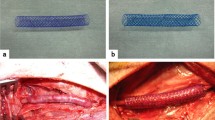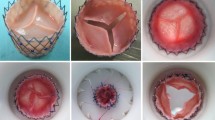Abstract
Chronic venous insufficiency (CVI) remains a major health problem worldwide. Direct venous valve surgical repair and venous segment transplantation are clinical options; however, they are highly invasive procedures. The objectives of this study were to fabricate prosthetic venous valves (PVVs) by electrospinning, for percutaneous treatment of CVI, and evaluate their hydrodynamic characteristics in vitro at the same locations and under the same flow conditions. The PVVs consisted of polyurethane fiber scaffolds attached to a cobalt–chromium stent. PVVs with two different valve-leaflet configurations were compared: biomimetic PVV (bPVV) and open PVV (oPVV). A balloon catheter was used to implant the devices in a poly(vinyl chloride) tube and the column outlet was set at a height of 100 cm above the test valve to simulate the elevation of the heart above a distal vein valve while standing; 50 wt% glycerin solution was used as the test fluid. The devices were evaluated for antegrade flow, effect of ankle flexion, and stagnation zones around the valve leaflets. During sudden hydrostatic backpressure, little leakage and constant peripheral pressure were observed for the devices; under forward pulsatile pressure of 0–4 mmHg, to simulate the effect of breathing, the oPVV had a higher flow rate than the bPVV. With regard to the effect of ankle flexion, the oPVV was functionless. Moreover, the stagnation zone around the oPVV valve leaflets was larger than that around the bPVV valve leaflets. These results suggest that the bPVV would be clinically suitable for percutaneous treatment of CVI.









Similar content being viewed by others
References
Criado E, Johnson G Jr. Venous disease. Curr Probl Surg. 1991;28:339–400.
Callam MJ, Ruckley CV, Harper DR, Dale JJ. Chronic ulceration of the leg: extent of the problem and provision of care. Br Med J. 1985;290:1855–6.
White GH. Chronic venous insufficiency. In: Veith FJ, Hobson II RW, Williams RA, Wilson SE, editors. Vascular surgery: principles and practice. 2nd ed. New York: McGraw-Hill; 1993. p. 865–8.
Masuda EM, Kistner RL. Long-term results of venous valve reconstruction: a four- to twenty-one-year follow-up. J Vasc Surg. 1994;19:391–403.
Rosales A, Jørgensen JJ, Slagsvold CE, Stranden E, Risum Ø, Kroese AJ. Venous valve reconstruction in patients with secondary chronic venous insufficiency. Eur J Vasc Endovasc Surg. 2008;36:466–72.
Raju S, Fredericks R. Valve reconstruction procedures for nonobstructive venous insufficiency: rationale, techniques, and results in 107 procedures with two- to eight-year follow-up. J Vasc Surg. 1988;7:301–10.
MacKenzie RK, Allan PL, Ruckley CV, Bradbury AW. The effect of long saphenous vein stripping on deep venous reflux. Eur J Vasc Endovasc Surg. 2004;28:104–7.
Nwaejike N, Srodon PD, Kyriakides C. 5-years of endovenous laser ablation (EVLA) for the treatment of varicose veins—a prospective study. Int J Surg. 2009;7:347–9.
Maleti O, Lugli M. Neovalve construction in postthrombotic syndrome. J Vasc Surg. 2006;43:794–9.
Lugli M, Guerzoni S, Garofalo M, Smedile G, Maleti O. Neovalve construction in deep venous incompetence. J Vasc Surg. 2009;49:156–62.
Uflacker R. Percutaneously introduced artificial venous valve: experimental use in pigs. In: Proceedings of the 1993 Annual Meeting of the Western Angiographic and Interventional Society, Portland, OR, September 29–October 3, 1993, p. 30.
Thorpe PE, Osse FJ, Correa LO. The valve-stent: development of a percutaneous prosthesis for treatment of valvular insufficiency. In: Proceedings of the Twelfth Annual Meeting of the American Venous Forum, Phoenix, AZ, February 3–6, 2000, p. 82.
Pavcnik D, Uchida BT, Timmermans HA, Keller FS, Rösch J. Aortic and venous valve for percutaneous placement. Minim Invasive Ther Allied Technol. 2000;9:287–92.
Gomez-Jorge J, Venbrux AC, Magee C. Percutaneous development of a valved bovine jugular vein in the swine venous system: a potential treatment for venous insufficiency. J Vasc Interv Radiol. 2000;11:931–6.
Pavcnik D, Uchida BT, Timmermans HA, Corless CL, O’Hara M, Toyota N, Moneta GL, Keller FS, Rösch J. Percutaneous bioprosthetic venous valve: a long-term study in sheep. J Vasc Surg. 2002;35:598–602.
de Borst GJ, Teijink JA, Patterson M, Quijano TC, Moll FL. A percutaneous approach to deep venous valve insufficiency with a new self-expanding venous frame valve. J Endovasc Ther. 2003;10:341–9.
Pavcnik D, Kaufman JA, Uchida BT, Correa LO, Hiraki T, Kyu SC, Keller FS, Rösch J. Second-generation percutaneous bioprosthetic valve: a short-term study in sheep. J Vasc Surg. 2004;40:1223–7.
Pavcnik D, Kaufman JA, Uchida BT, Case B, Correa LO, Goktay AY, Hamada A, Keller FS, Rösch J. Significance of spatial orientation of percutaneously placed bioprosthetic venous valves in an ovine model. J Vasc Interv Radiol. 2005;16:1511–6.
Pavcnik D. Update on venous valve replacement: long term clinical results. Vascular. 2006;14:106.
Rittgers SE, Oberdier MT, Pottala S. Physiologically-based testing system for the mechanical characterization of prosthetic vein valves. Biomed Eng Online. 2007;6:29.
Oberdier MT, Rittgers SE. The design, development, and evaluation of a prototypic, prosthetic venous valve. Biomed Eng Online. 2008;7:25.
Yoshimoto H, Shin YM, Terai H, Vacanti JP. A biodegradable nanofiber scaffold by electrospinning and its potential for bone tissue engineering. Biomaterials. 2003;24:2077–82.
Kenawyel R, Layman JM, Watkins JR, Bowlin GL, Matthews JA, Simpson DG, Wnek GE. Electrospinning of poly(ethylene-co-vinyl alcohol) fibers. Biomaterials. 2003;24:907–13.
Kuraishi K, Iwata H, Nakano S, Kubota S, Tonami H, Toda M, Toma N, Matsushima S, Hamada K, Ogawa S, Taki W. Development of nanofiber-covered stents using electrospinning: in vitro and acute phase in vivo experiments. J Biomed Mater Res B Appl Biomater. 2009;88:230–9.
Matsubara J. Der Einfluss arterieller Durchblutungsstoerungen auf den Venendruck des Fusses. VASA. 1979;8:221–5.
Pollack AA, Wood EH. Venous pressure in the saphenous vein at the ankle in man during exercise and changes in posture. J Appl Physiol. 1949;1:649–62.
Sumner DS. Applied physiology in venous problems. In: Bergan JJ, Yao JST, editors. Surgery of the veins. Orlando: Grune and Stratton; 1985. p. 3–23.
Acknowledgments
This work was supported by JSPS KAKENHI (no. 21700505) Grant-in-Aid for Young Scientists (B).
Author information
Authors and Affiliations
Corresponding authors
Rights and permissions
About this article
Cite this article
Moriyama, M., Kubota, S., Tashiro, H. et al. Evaluation of prosthetic venous valves, fabricated by electrospinning, for percutaneous treatment of chronic venous insufficiency. J Artif Organs 14, 294–300 (2011). https://doi.org/10.1007/s10047-011-0588-2
Received:
Accepted:
Published:
Issue Date:
DOI: https://doi.org/10.1007/s10047-011-0588-2




